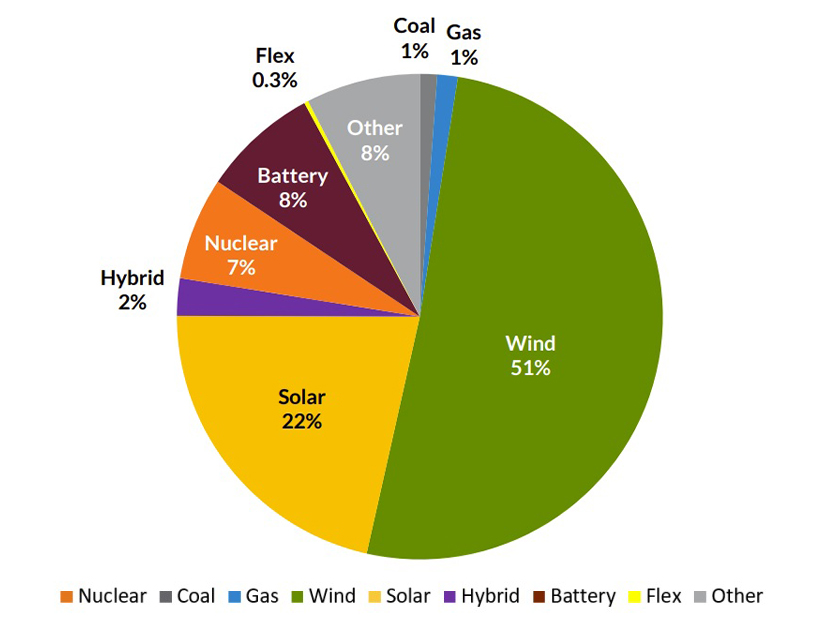MADISON, Wis. — MISO says it’s on track this year to map the new transmission lines required for its second long-range transmission plan (LRTP) portfolio.
“We’re facing unprecedented circumstances, new conditions coming at us faster,” Aubrey Johnson, vice president of system planning, said Tuesday during the Board of Directors’ System Planning Committee meeting.
Johnson said resource churn is driving MISO’s need to pull together a second Midwestern LRTP portfolio. He said staff are planning to regularly update 20-year transmission planning futures after a refresh this year revealed dramatic changes since the previous update in 2020 (See MISO: Long-range Tx Needed for 369 GW in Interconnections.)
“The system we’re operating, and the plans our members have are dynamic, and they’re changing day by day,” Johnson said.
The grid operator has finalized the second of the portfolio’s three futures, a mostly decarbonized scenario that anticipates a 2042 energy mix comprised of 51% wind, 22% solar, 8% battery, 8% other resources and 7% nuclear. It also includes a 2% hybrid with renewables paired with storage and a 1% contribution each from coal and natural gas.
MISO hopes that the last 0.3% of the energy mix will come from 29 GW of “flex” resources, yet undefined resources that are expected to be a dependable, on-call source of firm capacity.
The second future projects MISO will operate with 466 GW of nameplate capacity. That is broken down into 160 GW of wind generation, 112 GW of solar, 65 GW of natural gas, 41 GW of other generation, 31 GW of battery storage, 29 GW of “flex” resources, 12 GW of nuclear, 10 GW of storage and 6 GW of coal.
Johnson said though the RTO still expects to operate several gigawatts of gas and coal facilities, their energy contributions will be on a strictly as-needed basis.
“We need to have these resources, but they’re going to be used very infrequently. But when they’re needed, they’re needed,” Johnson stressed.
MISO foresees risks during calm, hot summer days when the wind doesn’t pick up after sunset and during winter daytime load peaks, where there’s a risk of unserved energy before sunrise and after sunset. Johnson referred to those risky periods as the grid operator’s “twilight problem.”
He said staff are anticipating escalating thermal generation retirement requests and are preparing to study them. MISO plans to complete the second LRTP portfolio’s modeling by early fall. That modeling will inform which projects MISO ultimately recommends.
“We’re getting ready for the sprint, if you will,” Johnson said.
Johnson said it’s getting more challenging to feasibly model a future system that can reliably serve load with the resource mixes on the horizon.
“In reality, we’re probably behind in the way we’ve done some of our economic analysis,” he told board members.
Senior Director of Transmission Planning Laura Rauch said MISO’s resource expansion tool currently used for transmission planning was intended to account for large baseload power sources, not siting a host of scattered wind and solar facilities.
Johnson said the RTO’s forthcoming proposal to tighten rules around when developers can enter and exit the interconnection queue should make clear to planners the future mix they’re planning for. (See MISO Wants Tougher Obligations on Queue Entry and Exit.)
He said MISO is hoping to encourage generation plans that are “targeted toward completion rather than targeting holding a place in the queue.”
The grid operator’s current generator interconnection queue contains 1,379 active projects totaling a little more than 237 GW. Almost all of that is renewable energy or battery storage.
“Future generations are depending on this to get this done and get it done right,” director Mark Johnson said of the expansion planning.
Ciaran Gallagher, with nonprofit Clean Wisconsin, said MISO is neglecting storage resources in its annual transmission and LRTP planning. She said there’s “insufficient” representation of battery storage in modeling and the RTO’s assumptions don’t represent the projects in the queue.
Gallagher said storage and hybrid resources can “bolster the grid with attributes” that MISO is losing through thermal generation retirements. She said more battery storage incorporation must be considered “to plan the optimal grid.”
ROFR Developments May Complicate LRTP Planning
Johnson also addressed right-of-first refusal (ROFR) legislation activity in the MISO footprint.
He said staff are monitoring developments in Illinois and Iowa. A bill in the former that would specifically give Ameren Illinois exclusive rights to build regional MISO lines has passed both houses and is awaiting the governor’s signature (HB 3445). Iowa’s ROFR law has been temporarily overturned, pending a final ruling from a district court. (See Iowa Regulators Ponder MISO Tx Projects After ROFR Ruling.)
Both developments could determine which utilities are allowed to construct some projects in the LRTP portfolios.
“There’s a lot of activity we’re following and working with our legal team to understand the implications,” Johnson told board members.



